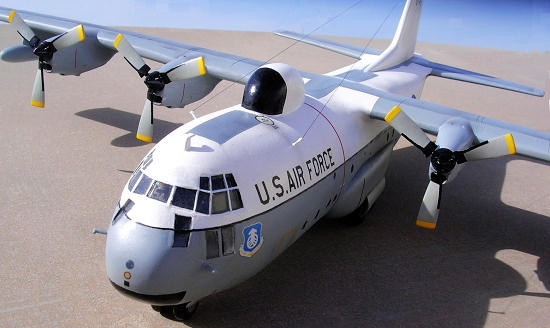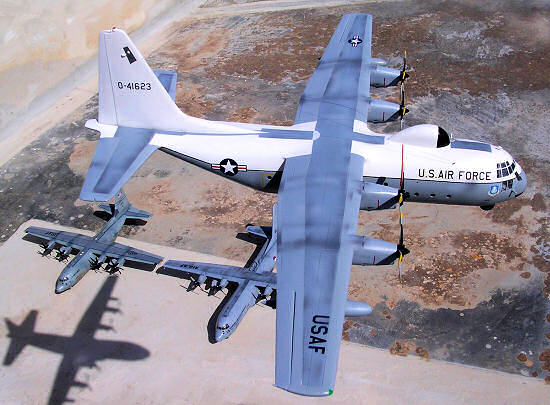Airfix
1/72 JC-130A Hercules
|
KIT #: |
|
|
PRICE: |
30 Euro |
|
DECALS: |
Airfix usually gives 2-3 options |
|
REVIEWER: |
Carmel J. Attard |
|
NOTES: |
Airmodel vac conversion AM-59
£9.90 sterling |

The Hercules was
conceived in 1951 when the USAF took a policy decision to re-equip with
turboprop-powered transports. First flight of the YC-130 prototype was made on
August 23, 1954
and delivery of the C-130A tactical transport began in December 1956, and
production being complete in February 1959 with the 231st
machine. Twelve were delivered to the R.A.A.F., two more
 modified
as GC-130A drone launcher graphic aircraft, sixteen were completed as RC-130A
photographic aircraft, and twelve were fitted with JATO, wheel/ski
undercarriages and under wing fuel tanks as C-130Ds.
modified
as GC-130A drone launcher graphic aircraft, sixteen were completed as RC-130A
photographic aircraft, and twelve were fitted with JATO, wheel/ski
undercarriages and under wing fuel tanks as C-130Ds.
The
A variant was the first of a long line of transport serving aircraft and were
extensively used during the
Vietnam
era and in surrounding
South East Asia.
Manned spacecraft tracking JC-130A were assigned to Patrick AFB, FL., attached
to Air Force Systems Command. The C-130A with roman nose (APS42
radar) versus Pinocchio nose (APN-59
radar) also varied in other respects. The 53- and 54-year models had the
clamshell nose gear doors. Later single door retrofitted to most but not early
C-130As. The forward cargo had extra window. There were lack of wing tanks or
retrofitted smaller 450-gallon outer wing tank (C-130A) versus (C-130B) which
had no outer wing tanks but larger 1350-gallon centre wing tank (C-130E or later
models). The C-130A T-57-A9 engines set further into wings with Aero Products
three bladed propellers and the engine fairings extended up to the flaps (inner
engines) and into the flaps (outer engines) The C-130B and later have fairings
well before the flaps. C-130A, C-130Bs and 61-year C-130Es all had forward cargo
door.
There were serious accidents where the door opened in flight caused the
doors to be permanently closed.
 Building
a JC-130A to a scale of 1/72 involved making use of the old Airfix kit in
combination with vac-form parts from the variety offered in the Airmodel kit
AM-59. Little can be said on the Airfix kit as it is now out of production and
more improved C-130 kits have emerged since. This had raised panel lines which
all needed to be accurately re-scribed apart from the modifications required to
convert the kit into a JC-130A.
Building
a JC-130A to a scale of 1/72 involved making use of the old Airfix kit in
combination with vac-form parts from the variety offered in the Airmodel kit
AM-59. Little can be said on the Airfix kit as it is now out of production and
more improved C-130 kits have emerged since. This had raised panel lines which
all needed to be accurately re-scribed apart from the modifications required to
convert the kit into a JC-130A.
The Airmodel parts issued for this conversion are namely a roman
nose that comes in two halves and the roof radome, which also is a two-part
item. Airmodel kit AM-59 also has part items to make any of the following
Hercules versions: C-130A; JC-130A; C-130B; KC-130F; HC-130H; WC-130H; HC-130P;
MC-130E; L-100-20; L-100-30 and the RAF C Mk3 and C-130H-30. There are line
drawings side views to indicate principal shape of each version. The Airfix kit
in spite of its age is basically of an acceptable standard. A little extra work
was required to improve on the lower engine air intake fronts and reshape the
lower air intakes. Additional work made on the kit was as follows.
Front fuselage halves had an extra window
drilled of same diameter and in same line with existing ones. Cockpit office was
assembled as per instructions and more detail added to the nose wheel well. This
also had modified clamshell type doors, which were common with the earlier
C-130As.
Lead weight added to an enclosed compartment and having painted all
interior colours, main wheel well and legs added to fuselage and the main halves
were then glued together allowing time for the now complete fuselage to set.
 The
next step was to figure out the sawing of the standard Pinocchio nose and bring
the assembled roman nose to the best fit, making adjustment as required using
smooth filing. This should form a near straight line when viewed from side
elevation with the Perspex cabin canopy. The joint resulted in a negligible
overlap but I did not like the lower side windows kit fit and in the end this
also resulted into an acceptable appearance after smoothening and adding filler
to obtain the correct shape at the side of the nose area. The hump radome
fairing was then added to top of fuselage giving the Hercules the main salient
feature of a JC-130A. The hump joining face was of correct shape to match the
upper curvature of the fuselage. The fuselage was set aside and the attention
was drawn towards the wing panel lines which had to be scribed.
The
next step was to figure out the sawing of the standard Pinocchio nose and bring
the assembled roman nose to the best fit, making adjustment as required using
smooth filing. This should form a near straight line when viewed from side
elevation with the Perspex cabin canopy. The joint resulted in a negligible
overlap but I did not like the lower side windows kit fit and in the end this
also resulted into an acceptable appearance after smoothening and adding filler
to obtain the correct shape at the side of the nose area. The hump radome
fairing was then added to top of fuselage giving the Hercules the main salient
feature of a JC-130A. The hump joining face was of correct shape to match the
upper curvature of the fuselage. The fuselage was set aside and the attention
was drawn towards the wing panel lines which had to be scribed.
The wing parts were then assembled and engines added leaving the
propellers aside to fix during the final stage. Wing ailerons were also
permanently fixed. A new placement for the wing pylon was measured to fit on the
outer part of the wings. The fuel tank were also shortened and modified. The T-56-A9
engines set further into wings, adding putty filler to the rear of engines to
take the form described earlier and which differed from the later versions that
had shorter nacelles in appearance. A set of three bladed props replaced the
4-blade ones that came from spares box.
 The
sand colour plastic of the Airfix kit required liberal coats of Model Master
semi gloss white spraying to the upper fuselage which was then masked with
Tamiya masking tape and paper. The black underside of fuselage along with the
black front of nose and dorsal radomes were then air brushed in gloss black
Humbrol paint. This was again masked and the kit was ready to receive the grey
applied to the wings and rest of fuselage. I noticed that the wings and fuselage
colour demarcation varied between one C-130 and another and exact reference to
photos of the particular one being built was necessary. Some even had white
wings while others had metal finish wings with grey top walkways.
The
sand colour plastic of the Airfix kit required liberal coats of Model Master
semi gloss white spraying to the upper fuselage which was then masked with
Tamiya masking tape and paper. The black underside of fuselage along with the
black front of nose and dorsal radomes were then air brushed in gloss black
Humbrol paint. This was again masked and the kit was ready to receive the grey
applied to the wings and rest of fuselage. I noticed that the wings and fuselage
colour demarcation varied between one C-130 and another and exact reference to
photos of the particular one being built was necessary. Some even had white
wings while others had metal finish wings with grey top walkways.
Decals came from different sheet sources. All
USAF legends came from Scale Master sheet SM-32B, and the USAF insignias came
from Super Scale No72-83. From Aeromaster decal sheet I found the right size of
45 degrees ID letters and numbers in black. The black trim was picked from Micro
scale decal sheet No 72-195 and the Air Force Systems Command crest was picked
from Super Scale sheet No 72-190, which contained a variety of crest sizes.
Once you do one C-130 you start to plan the next
one since there are so many attractive color
schemes, different shapes and missions for the type. I
always wanted to build an A version as the development of the C-130 brought
about such a variety of different fuselage shapes. This is what modelling is all
about; doing things out of the ordinary that in the end makes them look a
showstopper among other C-130s. This was a fairly difficult conversion but
definitely within reach of the above average modeller who is looking for a kit
conversion adventure.
Carmel J.
Attard
October 2012
If you would like your product reviewed fairly and fairly quickly, please
contact
the editor or see other details in the
Note to
Contributors.
Back to the Main Page
Back to the Review Index Page
modified
as GC-130A drone launcher graphic aircraft, sixteen were completed as RC-130A
photographic aircraft, and twelve were fitted with JATO, wheel/ski
undercarriages and under wing fuel tanks as C-130Ds.
The
next step was to figure out the sawing of the standard Pinocchio nose and bring
the assembled roman nose to the best fit, making adjustment as required using
smooth filing. This should form a near straight line when viewed from side
elevation with the Perspex cabin canopy. The joint resulted in a negligible
overlap but I did not like the lower side windows kit fit and in the end this
also resulted into an acceptable appearance after smoothening and adding filler
to obtain the correct shape at the side of the nose area. The hump radome
fairing was then added to top of fuselage giving the Hercules the main salient
feature of a JC-130A. The hump joining face was of correct shape to match the
upper curvature of the fuselage. The fuselage was set aside and the attention
was drawn towards the wing panel lines which had to be scribed.